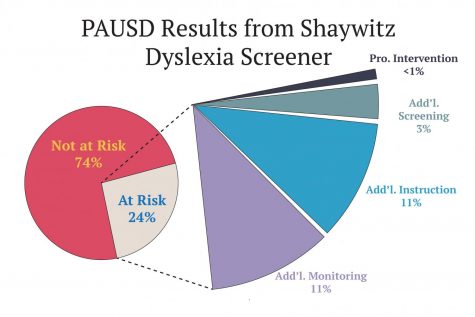New district dyslexia study brings changes to teacher instruction
February 25, 2020

Following the “staggering” results of an early identification program for students at risk of dyslexia this month, over 500 Palo Alto Unified School District students have started to receive additional monitoring or specialized services, according to Supt. Don Austin.
As part of its ongoing efforts to boost literacy by diagnosing dyslexia early, PAUSD educators administered the Shaywitz Dyslexia Screener to 2,100 K-3 students.
“The initial results, although consistent with research, were staggering, resulting in identification of 546 (26%) of students in grades 1-3 as at-risk with kindergarten assessments commencing shortly,” Austin wrote in a statement.
Of the 546 students deemed at-risk, 239 will receive additional monitoring without specialized services, 225 will receive additional in- and out-of-class instruction, 73 were referred for further testing and nine were referred to Tier III supports which includes professional interventions.
“An administrator of this screener rates statements regarding a student’s language and frequency of academic behaviors,” said Leslie Faust, literacy lead for the District’s Elementary Education Department. “This screener allows teachers and support staff to identify those students who may be at risk for reading difficulties, such as dyslexia.”
The results of the study are on par with most modern research, which suggests that 14 to 17% of people are dyslexic yet only a fraction of that number are properly diagnosed.
“At the time when young learners are forming efficacy and expectancy mindsets that will last throughout their schooling careers, dyslexia gives the impression of an inability to read,” Austin wrote. “Without the skills to access reading, students often lag behind their peers and earn poor grades in content courses.”
While the district’s new efforts to provide reading support focus primarily on elementary school, students at all ages will begin to see changes. For example, students at Gunn High School are receiving reading comprehension tests as part of the Universal Protocol for Accommodations in Reading.
Furthermore, fourth graders who scored poorly on the California Assessment of Student Performance and Progress, as well as students who are struggling in the fifth grade, will be referred for additional support in middle school.
In addition to supplementary screening, some reading and education specialists at PAUSD are changing the way they support students by applying the Orton-Gillingham Approach to embed new strategies into existing academic programs. The OG Approach is a form of sensory-based instruction, where educators combine words on a page with auditory, visual, and kinesthetic elements. For example, to learn the letter “A,” students might say it aloud as they draw it in the air.
“The Elementary Teachers on Special Assignment will also be attending training in March with the lens of how and where multisensory teaching strategies can be implemented in the current literacy program,” Faust said. “TOSAs will then provide this streamlined professional learning to all elementary teachers and support staff.”
Faust is hopeful that these new programs will give all students, especially those with special needs, access to the resources they need to succeed.
“As teachers and support staff continue to monitor those students in need of additional supports, school sites are seeing an increase in small group and differentiated instruction,” Faust said. “Now that school sites can further identify a student’s reading difficulties, teachers and support staff can design a learning plan where students can be confident and successful learners.”









![A protester in a chicken suit wearing a taco hat with the words “Cluck Trump” at the “No Kings” Democracy Fair in Palo Alto on Saturday. Protestor Mary Chan said she and her husband are horrified at the state of science and medicine in America. “What he [Trump] is doing by defunding scientific research is destroying our academic medical centers, and he’s [Trump] bankrupting rural medical centers,” Chan said. “We will have lasting negative impacts on American health for decades.”](https://palyvoice.com/wp-content/uploads/2025/10/11562FFE-9912-4152-BB01-582426B52ECB_1_105_c-225x300.jpeg)
Beverly Salmans • Mar 11, 2020 at 4:43 pm
Teacher training programs should teach students how to recognize dyslexia and refer students for testing by psychometrists who understand dyslexia and know which tests to administer to correctly identify it. School districts should then provide therapists trained in an Orton Gillingham program approved by ALTA (Academic Language Therapy Association) and IDA (International Dyslexia Association) to administer therapy to these students. Dyslexia therapy is intense, systematic, direct instruction that should be delivered in one hour sessions for 4 to five days per week in order to remediate dyslexia.
Carla Trettin • Mar 4, 2020 at 2:23 pm
This is such an important discovery that can have a positive outcome for so many students and their parent/s caregivers
by using a Multi-sensory approach with each student and by training the Elementary Education Teachers in this method
we can begin to find the ways to reach each student’s way to learn visual ,auditory ,kinesthetic,etc.
PAUSD has alot to be proud of.
Christy • Feb 27, 2020 at 4:00 pm
It would be great if other districts could use this process as a model for improving literacy elsewhere. Will the Palo Alto district make their procedures and budgets for this project available publicly?